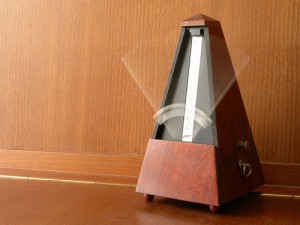If you’ve been reading my three part rhythm series, you now know why it’s important to play with proper rhythm and some ways to work on rhythm and the difference between the various types of metronomes and how to select the best one for your needs. Today I’ll share the final installment of the rhythm series and will explain when to use and how to use your metronome.
As I mentioned already, a metronome is one of the best tools out there to help musicians. For younger and less experienced musicians, it’s often not considered the most fun thing to use. In my opinion this is because it’s really challenging for most students to stay with the metronome until they get the swing of it. For most kids, it does not come naturally. Most children find the constant clicking to be annoying and distracting. Once the metronome no longer becomes a nuisance and students can figure out how to stay with it or how to jump back in on the beat if they get off, it becomes incredibly useful.
So in which instances will you want to use your metronome?
#1: When you have trouble playing with a steady beat
It is so common for students to play faster when their section of music is easier and slower when it’s challenging. They slow down to give themselves extra time to think and process what they are doing. Oddly enough, I will find myself sometimes doing the same thing when I’m playing a new piece. It’s funny that something I spend tons of time working with students on, is one of the same things that I’ll do myself if I’m not careful. This just shows me that this is a natural tendency for everyone.
#2: When you need help getting a piece faster
It is always the best to learn a piece on the slow side. That way you can really make sure you are learning the notes, rhythms, fingerings, and all other details accurately. If you play the piece too fast, it’s easy to miss important details, and once you’ve learned it a certain way, it’s so much harder to go back and change it. After you have the piece down at a slower tempo, using the metronome to increase the speed works incredibly well. The metronome can help you get your piece to a faster tempo little by little, which really is the best way to speed up a piece.
Now that you know when to use your metronome, I want to explain, how to use your metronome:
First of all, your teacher will let you know if he or she thinks using the metronome for a particular piece will be useful. Then he will give you an appropriate metronome marking based on how fast you are currently playing the piece. For example, maybe right now you comfortably play your piece at a quarter note = 60. Start by playing the piece at that speed.
If everything goes well and there are no sections you have any trouble with at that speed, increase the speed by a notch or two (in this case up to 64 or 68). If there are sections that you are unable to stay with the metronome (you fall behind or get off the beat), keep playing at 60 until that becomes completely comfortable.
Gradually increase the metronome speed one to two notches at a time until you eventually hit the target tempo. Take your time doing this, and only increase the metronome speed if you can play every portion of the piece with no difficulty at the current speed. Because you are increasing the speed gradually it will come together so much easier than if you went for a sudden huge jump in tempo.
Using the metronome will force you as I mentioned above to keep your beat steady. If you ever get out of sync with the metronome simply pause for a second, and jump back in on the beat. It is so much better to take a second to stop and get back in than to continue to play a little off from the metronome.
While using the metronome is amazing, I caution you from practicing only with the metronome. Doing so can take a bit of the musicality away and make things sound a bit mechanical. Mix up using the metronome and practicing without it to help without taking away the beauty of the piece.
Now I want to hear from you. What tips do you have to make playing with the metronome go smoothly? Leave a comment below with your thoughts. Thanks so much for reading my blog! Don’t forget to subscribe to the newsletter list if you’d like to receive these articles every week. Also, please “like us” on Facebook. Have an awesome day!
Sincerely,
Cassie

{ 3 comments… read them below or add one }
Dear Cassie,
You can use the metronome also slowing down. It is very relaxing when you decrease the tempo while. praticing at a comfortable tempo. It mproves the rhythmic precision also.
Sincerely,
Kees Stikkers
Hi Kees,
You are so right! We often forget about using the metronome to slow down. Thanks for your comment!
Hi Cassie,
It is very useful to start the metronome, listen carefully for the tempo, stop the metronome and play about 2 or 4 bars. Then stop playing and check the tempo with the metronome. This will enhance an even pulse, but in the end your playing will sound more natural. Doing so will make you aware of very subtle tempo deviations. These ‘ripples’ are extremely important because they determine your musical expression. Always use a metronome for musical purposes.
Sincerely,
Kees Stikkers